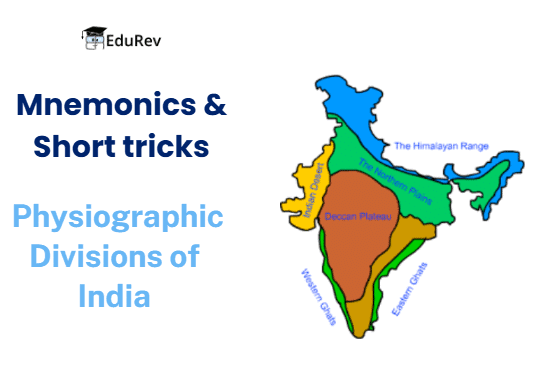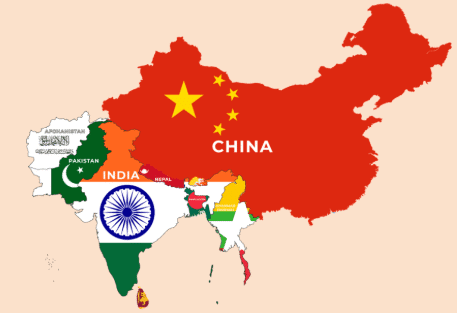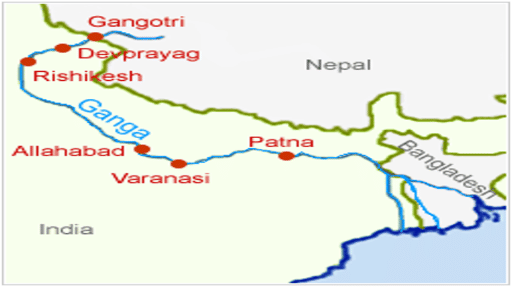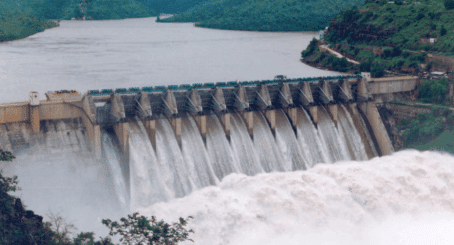Mnemonics : Introduction to Physiographic Divisions | Geography for UPSC CSE PDF Download
| Table of contents |

|
| Union Territories of India |

|
| India's Neighbouring Countries |

|
| Important Rivers of India |

|
| Major Ports of India |

|
| Important River Valley Projects |

|
This document will help you master the key aspects of Indian Geography in a simple and engaging way. Inside, you'll find easy memory tricks (mnemonics) to help you recall important rivers, , multipurpose projects, major natural resources and important ports, etc of India

Whether you're preparing for the UPSC, SSC CGL, or any other competitive exam, these mnemonics will make studying Indian Geography easier and more effective. Use them alongside your regular studies to remember facts faster and retain information for a longer time!
Union Territories of India
Mnemonic: "A Cool Dolphin Loves Jumping Near Lakes"
- A – Andaman & Nicobar Islands
- C – Chandigarh
- D – Dadra and Nagar Haveli & Daman and Diu
- L – Lakshadweep
- J – Jammu & Kashmir
- N – NCT of Delhi
- L – Ladakh
India's Neighbouring Countries
Mnemonic: "A Bold China Might Need Powerful Strategic Measures."
- A – Afghanistan (Regional security, Chabahar Port, Taliban issue)
- Bold – Bangladesh (Trade, water sharing, Act East Policy)
- China – China (Border disputes, trade competition, Indo-Pacific strategy)
- Might – Myanmar (Act East Policy, Kaladan project, Rohingya crisis, insurgency in Northeast)
- Need – Nepal (Cultural ties, China’s influence, border disputes)
- Powerful – Pakistan (Terrorism, Kashmir issue, nuclear rivalry)
- Strategic – Sri Lanka (Indian Ocean geopolitics, Hambantota Port, SAGAR initiative)
- Measures – Maldives (Maritime security, Neighbourhood First policy, China’s BRI influence)

Important Rivers of India
> Rivers Originating from the Himalayas
Mnemonic: Giant Soldiers Invade Risky Battle Journeys.
- Giant – Ganga (Gangotri Glacier)
- Soldiers – Satluj (Mansarovar Rakas Lakes)
- Invade – Indus (Near Mansarovar)
- Risky – Ravi (Kullu Hills, Rohtang Pass)
- Battle – Beas (Near Rohtang Pass)
- Journeys – Jhelum (Verinag, Kashmir)
> Rivers of the Indus River System (Five Tributaries)
Mnemonic: Be Ready, Jhelum Can Sink.
- Be – Beas
- Ready – Ravi
- Jhelum – Jhelum
- Can – Chenab
- Sink – Satluj
> Rivers that Fall into the Bay of Bengal
Mnemonic: Go Big And Catch Fast Kittens.
- Go – Ganga
- Big – Brahmaputra
- And – Mahanadi
- Catch – Cauvery
- Fast – Godavari
- Kittens – Krishna
> Rivers that Fall into the Arabian Sea
Mnemonic: No Teacher Loves Science.
- No – Narmada
- Teacher – Tapti
- Loves – Luni
- Science – Sabarmati
> Rivers Originating from the Western Ghats
Mnemonic: King Tigers Catch Giant Tuna.
- King – Krishna
- Tigers – Tungabhadra
- Catch – Cauvery
- Giant – Godavari
- Tuna – Tapti
> Rivers that Fall into the Gulf of Khambat
Mnemonic: No Tension, Study
- No – Narmada
- Tension – Tapti
- Study – Sabarmati
> Rivers that Fall into the Ganga

Mnemonic: Young Ganga Carries Great Kind Blessings, Son.
- Young – Yamuna
- Ganga – (Reference to the main river)
- Carries – Chambal
- Great – Ghagra
- Kind – Kosi
- Blessings – Betwa
- Son – Son
Major Ports of India
>Western Coast Ports
Mnemonic: "Kind Men Jog Many Miles Cheerfully."
- Kind – Kandla (Child of Partition)
- Men – Mumbai (Busiest and Biggest)
- Jog – Jawaharlal Nehru (Fastest Growing)
- Many – Mormugao (Naval Base Also)
- Miles – Mangalore (Exports Kudremukh Iron-Ore)
- Cheerfully – Cochin (Natural Harbour)
> Eastern Coast Ports
Mnemonic: "Kolkata People Visit Chennai Every Time Peacefully."
- Kolkata – Kolkata-Haldia (Riverine Port)
- People – Paradip (Exports Raw Iron to Japan)
- Visit – Visakhapatnam (Deepest Port)
- Chennai – Chennai (Oldest and Artificial)
- Every – Ennore (Most Modern, Private Hands)
- Time – Tuticorin (Southernmost)
- Peacefully – Port Blair (Strategically Important)
Important River Valley Projects
> Major Multi-Purpose River Projects

Mnemonic: "Big Brave Children Do Hard Tasks, Keeping Nature Thriving Forever."
- Big – Bhakra Nangal (Satluj, Punjab)
- Brave – Beas (Mandi Project, Himachal Pradesh)
- Children – Chambal Valley Project (Chambal, MP & Rajasthan)
- Do – Damodar Valley Project (Damodar, Bihar & Jharkhand)
- Hard – Hirakud (Mahanadi, Odisha)
- Tasks – Tehri (Bhagirathi, Uttarakhand)
- Keeping – Kosi (Kosi Project, Bihar)
- Nature – Nagarjuna Sagar (Krishna, Telangana & AP)
- Thriving – Tungabhadra (Tungabhadra, Karnataka & AP)
- Forever – Farakka (Ganga, West Bengal)
2. Important Hydroelectric & Irrigation Projects
Mnemonic: "Small Students Try Playing New Safe Games."
- Small – Salal (Chenab, J&K)
- Students – Sardar Sarovar (Narmada, Gujarat & MP)
- Try – Thein Project (Ravi, Punjab)
- Playing – Pong Dam (Ravi, Punjab)
- New – Nizamsagar (Manjra, Telangana)
- Safe – Sharavathi (Jog Falls, Karnataka)
- Games – Gandhisagar, Rana Pratap Sagar, Jawahar Sagar (Chambal, MP & Rajasthan)
|
175 videos|619 docs|192 tests
|
FAQs on Mnemonics : Introduction to Physiographic Divisions - Geography for UPSC CSE
| 1. What are physiographic divisions and why are they important in geography? |  |
| 2. How are physiographic divisions categorized? |  |
| 3. What are some examples of major physiographic divisions around the world? |  |
| 4. How do physiographic divisions affect climate and weather patterns? |  |
| 5. In what ways do human activities interact with physiographic divisions? |  |















